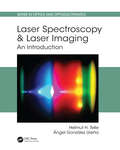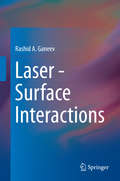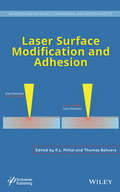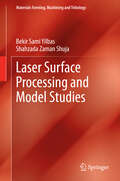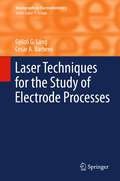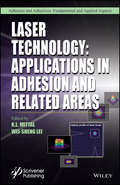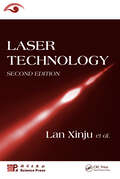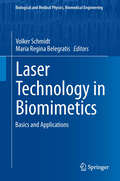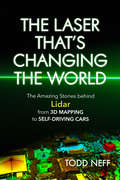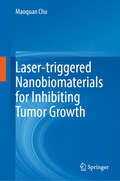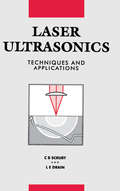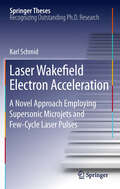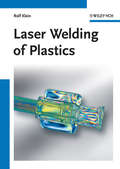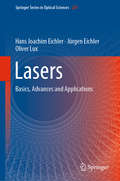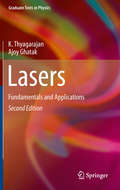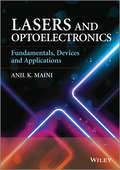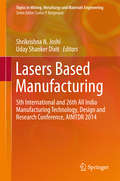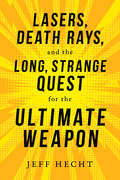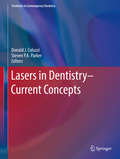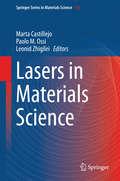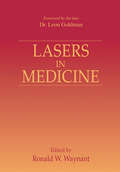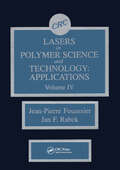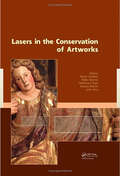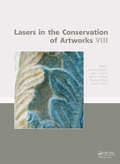- Table View
- List View
Laser Spectroscopy and Laser Imaging: An Introduction (Series in Optics and Optoelectronics)
by Helmut H. Telle Ángel González UreñaHow would it be possible to provide a coherent picture of this field given all the techniques available today? The authors have taken on this daunting task in this impressive, groundbreaking text. Readers will benefit from the broad overview of basic concepts, focusing on practical scientific and real-life applications of laser spectroscopic analysis and imaging. Chapters follow a consistent structure, beginning with a succinct summary of key principles and concepts, followed by an overview of applications, advantages and pitfalls, and finally a brief discussion of seminal advances and current developments. The examples used in this text span physics and chemistry to environmental science, biology, and medicine.
Laser - Surface Interactions
by Rashid A. GaneevThis book is about the interaction of laser radiation with various surfaces at variable parameters of radiation. As a basic principle of classification we chose the energetic or intensity level of interaction of laser radiation with the surfaces. These two characteristics of laser radiation are the most important parameters defining entire spectrum of the processes occurring on the surfaces during interaction with electromagnetic waves. This is a first book containing a whole spectrum of the laser-surface interactions distinguished by the ranges of used laser intensity. It combines the surface response starting from extremely weak laser intensities (~1 W cm-2) up to the relativistic intensities (~1020 W cm-2 and higher). The book provides the basic information about lasers and acquaints the reader with both common applications of laser-surface interactions (laser-related printers, scanners, barcode readers, discs, material processing, military, holography, medicine, etc) and unusual uses of the processes on the surfaces under the action of lasers (art conservation, rangefinders and velocimeters, space and earth explorations, surface engineering and ablation, and others). The scientific applications of laser-surfaces interactions (surface optical nonlinearities, surface enhanced Raman spectroscopy, surface nanostructuring, nanoripples and clusters formation, X-ray lasers and harmonic generation from the surfaces) are discussed from the point of view of the close relations between the properties of surface and matter, which is a cornerstone of most of studies of materials. The novelty of the approach developed in Laser - Surface Interactions is related with the interconnection of scientific studies with numerous applications of the laser-surface interactions separated in different chapters by the ranges of laser intensities. We present most recent achievements in this field. The book provides valuable information for different ranges of reader's preparedness to the laser-related topics (from unprepared readers, to students, engineers and researchers, professionals and academics).
Laser Surface Modification and Adhesion
by K. L. Mittal Thomas BahnersThe book provides a unique overview on laser techniques and applications for the purpose of improving adhesion by altering surface chemistry and topography/morphology of the substrate. It details laser surface modification techniques for a wide range of industrially relevant materials (plastics, metals, ceramics, composites) with the aim to improve and enhance their adhesion to other materials. The joining of different materials is of critical importance in the fabrication of many and varied products.
Laser Surface Processing and Model Studies
by Shahzada Zaman Shuja Bekir Sami YilbasThis book introduces model studies associated with laser surface processing such as conduction limited heating, surface re-melting, Marangoni flow and its effects on the temperature field, re-melting of multi-layered surfaces, laser shock processing, and practical applications. The book provides insight into the physical processes involved with laser surface heating and phase change in laser irradiated region. It is written for engineers and researchers working on laser surface engineering.
Laser Techniques for the Study of Electrode Processes
by Cesar A. Barbero Gyözö G. LángLaser-enabled measurements are valuable tools for the investigation of surfaces and interfaces or for the in situ investigation of interfacial processes including electrode processes. The understanding of the thermodynamics of solid/liquid surfaces is important for surface science and electrochemistry. In the first part of this book, the authors describe a range of techniques for investigating interfacial tension and surface stress, which is important for coatings, thin films, and fuel cells. The techniques covered comprise bending beam (bending plate, bending cantilever, wafer curvature) methods with different detection techniques. Special attention is given to methods using optical detection by laser beam deflection or interferometry. The second part is devoted to the techniques based on the detection of refractive index gradients in the solution. The refractive index changes could be related to concentration gradients (Probe Beam Deflection, PBD) or light-induced thermal gradients (Photothermal Deflection Spectroscopy, PDS). The application of the techniques to surface-confined and solution electrochemical systems is described. Subsequently, a comparison with others techniques able to monitor ion fluxes is performed.
Laser Technology: Applications in Adhesion and Related Areas
by K. L. Mittal Wei-Sheng LeiThe acronym Laser is derived from Light Amplification by Stimulated Emission of Radiation. With the advent of the ruby laser in 1960, there has been tremendous research activity in developing novel, more versatile and more efficient laser sources or devices, as lasers applications are ubiquitous. Today, lasers are used in many areas of human endeavor and are routinely employed in a host of diverse fields: various branches of engineering, microelectronics, biomedical, medicine, dentistry, surgery, surface modification, to name just a few.In this book (containing 10 chapters) we have focused on application of lasers in adhesion and related areas. The topics covered include:• Topographical modification of polymers and metals by laser ablation to create superhydrophobic surfaces.• Non-ablative laser surface modification.• Laser surface modification to enhance adhesion.• Laser surface engineering of materials to modulate their wetting behavior• Laser surface modification in dentistry.• Laser polymer welding.• Laser based adhesion testing technique to measure thin film-substrate interface toughness.• Laser surface removal of hard thin ceramic coatings.• Laser removal of particles from surfaces.• Laser induced thin film debonding for micro-device fabrication applications.
Laser Technology
by Lan XinjuAs different laser technologies continue to make it possible to change laser parameters and improve beam quality and performance, a multidisciplinary theoretical knowledge and grasp of cutting-edge technological developments also become increasingly important. The revised and updated Laser Technology, Second Edition reviews the principles and basic
Laser Technology in Biomimetics
by Volker Schmidt Maria Regina BelegratisLasers are progressively more used as versatile tools for fabrication purposes. The wide range of available powers, wavelengths, operation modes, repetition rates etc. facilitate the processing of a large spectrum of materials at exceptional precision and quality. Hence, manifold methods were established in the past and novel methods are continuously under development. Biomimetics, the translation from nature-inspired principles to technical applications, is strongly multidisciplinary. This field offers intrinsically a wide scope of applications for laser based methods regarding structuring and modification of materials. This book is dedicated to laser fabrication methods in biomimetics. It introduces both, a laser technology as well as an application focused approach. The book covers the most important laser lithographic methods and various biomimetics application scenarios ranging from coatings and biotechnology to construction, medical applications and photonics.
The Laser That's Changing the World: The Amazing Stories behind Lidar, from 3D Mapping to Self-Driving Cars
by Todd NeffTells the story of a laser technology that will have a big impact on society and the brilliant innovators responsible for its developmentLidar--a technology evolved from radar, but using laser light rather than microwaves--has found an astounding range of applications, none more prominent than its crucial role in enabling self-driving cars. This accessible introduction to a fascinating and increasingly vital technology focuses on the engaging human stories of lidar's innovators as they advance and adapt it to better understand air, water, ice and Earth - not to mention mapping Mars and Mercury, spotting incoming nuclear warheads, and avoiding pedestrians and cyclists on city streets. Award-winning science writer Todd Neff invites readers behind the scenes to meet some of the great innovators who have explored and expanded the uses of this amazing technology: people like MIT scientist Louis Smullin, whose lidar bounced light off the moon soon after the laser's invention; Allan Carswell, who plumbed the shallows of Lake Erie en route to developing the aerial lidar now essential for coastal mapping and hurricane damage assessment; Red Whittaker, the field robotics pioneer who was putting lidar on his autonomous contraptions as early as the 1980s; and David Hall, whose laser sombrero on a Toyota Tundra gave birth to modern automotive lidar.These are just some of the stories Neff tells before looking ahead to a future that could bring lidar to unpiloted air taxis, to the contaminated pipes of the U.S. nuclear weapons complex, and to satellites capable of pinpointing greenhouse gas sources from orbit. As the author makes clear, the sky is no limit with lidar, which promises to make our world safer, healthier, and vastly more interesting.
Laser-triggered Nanobiomaterials for Inhibiting Tumor Growth
by Maoquan ChuThis book focuses on laser-triggered nanobiomaterials for tumor inhibition. In this book, magnetic iron oxide nanoparticle-mediated cancer PTT through intratumoral or/and intravenous injection is introduced first. The benefits of intratumoral injection and the main factors affecting the retention of materials and permeability in solid tumors have been discussed. Furthermore, an attempt has been made to explore the performance of magnetic iron oxide nanoparticles after intravenous injection for tumor-targeted PTT based on several strategies. The latter part probes the gaps to improve magnetic iron oxide nanoparticle-mediated PTT through intratumoral and intravenous injection modes. This book also includes discussion on drug-loaded magnetic nanocomposites, magnetic iron oxide/Au nanocomposites, and magnetic iron oxide/semiconductor nanocrystal nanocomposites for combination cancer therapy, and enhanced cancer PTT has also been included as an integral part. This book also summarizes the most investigated photothermal agents, including noble metal nanoparticles, especially gold nanostars, hollow mesoporous copper sulfide nanoparticles, carbon-based nanoparticles, especially carbon nanotubes and graphic carbon nanocages, black phosphorous nanosheets, conjugated polymer nanoparticles, and organic dye nanoparticles. This book is useful for undergraduate and postgraduate students to better understand this research area. It may also provide useful information for technical nonspecialists whose background is in nanoscience and nanotechnology, biology, medicine, pharmacy, materials, chemistry, and physics.
Laser Ultrasonics Techniques and Applications
by L.E DrainThe first book devoted to laser techniques in the generation and reception of ultrasonic waves in materials, Laser Ultrasonics: Techniques and Applications provides a full description of the state of the art in all fields involving both lasers and ultrasonics. This practical book focuses mainly on the possible applications of the techniques, yet th
Laser Wakefield Electron Acceleration
by Karl SchmidThis thesis covers the few-cycle laser-driven acceleration of electrons in a laser-generated plasma. This process, known as laser wakefield acceleration (LWFA), relies on strongly driven plasma waves for the generation of accelerating gradients in the vicinity of several 100 GV/m, a value four orders of magnitude larger than that attainable by conventional accelerators. This thesis demonstrates that laser pulses with an ultrashort duration of 8 fs and a peak power of 6 TW allow the production of electron energies up to 50 MeV via LWFA. The special properties of laser accelerated electron pulses, namely the ultrashort pulse duration, the high brilliance, and the high charge density, open up new possibilities in many applications of these electron beams.
Laser Welding of Plastics: Materials, Processes and Industrial Applications
by Rolf KleinThis is the first detailed description in English of radiation and polymeric material interaction and the influences of thermal and optical material properties. As such, it provides comprehensive information on material and process characteristics as well as applications regarding plastic laser welding. The first part of this practical book introduces the structure and physical properties of plastics, before discussing the interaction of material and radiation in the NIR and IR spectral range. This is followed by an overview of the physical foundations of laser radiation and laser sources used for plastic welding. The third part describes the main processes of laser welding thermoplastics, as well as possibilities of process control, design of joint geometry, material compatibilities and adaptation of absorption of plastics to NIR radiation. Finally, the author explains applications of laser welding plastics using several industrial case studies from the automotive industry, household goods, and medical devices. Tailored to the needs of everyone dealing with laser welding of plastics, especially engineers in packaging, component manufacturing, and the medical industry.
Lasers: Basics, Advances and Applications (Springer Series in Optical Sciences #220)
by Hans Joachim Eichler Jürgen Eichler Oliver LuxThis book provides a comprehensive overview of laser sources and their applications in various fields of science, industry, and technology. After an introduction to the basics of laser physics, different laser types and materials for lasers are summarized in the context of a historical survey, outlining the evolution of the laser over the past five decades. This includes, amongst other aspects, gas lasers, excimer lasers, the wide range of solid-state and semiconductor lasers, and femtosecond and other pulsed lasers where particular attention is paid to high-power sources. Subsequent chapters address related topics such as laser modulation and nonlinear frequency conversion. In closing, the enormous importance of the laser is demonstrated by highlighting its current applications in everyday life and its potential for future developments. Typical applications in advanced material processing, medicine and biophotonics as well as plasma and X-ray generation for nanoscale lithography are discussed. The book provides broad and topical coverage of laser photonics and opto-electronics, focusing on significant findings and recent advances rather than in-depth theoretical studies. Thus, it is intended not only for university students and engineers, but also for scientists and professionals applying lasers in biomedicine, material processing and everyday consumer products. Further, it represents essential reading for engineers using or developing high-power lasers for scientific or industrial applications.
Lasers
by Ajoy Ghatak K. ThyagarajanEver since their invention in 1960, lasers have assumed tremendous importance in the fields of science, engineering and technology because of their use both in basic research and in various technological applications. Lasers: Theory and Applications 2nd Edition will provide a coherent presentation of the basic physics behind the working of the laser along with some of their most important applications. Numerical examples are scattered throughout the book for helping the student gain a better appreciation of the concepts and problems at the end of each chapter and provides the student a better understanding of the basics and help in applying the concepts to practical situations. This book serves as a text in a course on lasers and their applications for students majoring in various disciplines such as Physics, Chemistry and Electrical Engineering.
Lasers and Electro-optics
by Christopher C. DavisThis comprehensive textbook provides a detailed introduction to the basic physics and engineering aspects of lasers, as well as to the design and operational principles of a wide range of optical systems and electro-optic devices. Throughout, full details of important derivations and results are given, as are many practical examples of the design, construction and performance characteristics of different types of lasers and electro-optic devices. Covering a broad range of topics in modern optical physics and engineering, this book will be invaluable to those taking undergraduate courses in laser physics, optoelectronics, photonics and optical engineering. It will also act as a useful reference for graduate students and researchers in these fields.
Lasers and Optoelectronics
by MainiWith emphasis on the physical and engineering principles, this book provides a comprehensive and highly accessible treatment of modern lasers and optoelectronics. Divided into four parts, it explains laser fundamentals, types of lasers, laser electronics & optoelectronics, and laser applications, covering each of the topics in their entirety, from basic fundamentals to advanced concepts.Key features include:exploration of technological and application-related aspects of lasers and optoelectronics, detailing both existing and emerging applications in industry, medical diagnostics and therapeutics, scientific studies and Defence.simple explanation of the concepts and essential information on electronics and circuitry related to laser systemsillustration of numerous solved and unsolved problems, practical examples, chapter summaries, self-evaluation exercises, and a comprehensive list of references for further readingThis volume is a valuable design guide for R&D engineers and scientists engaged in design and development of lasers and optoelectronics systems, and technicians in their operation and maintenance. The tutorial approach serves as a useful reference for under-graduate and graduate students of lasers and optoelectronics, also PhD students in electronics, optoelectronics and physics.
Lasers Based Manufacturing
by Shrikrishna N. Joshi Uday Shanker DixitThis book presents selected research papers of the AIMTDR 2014 conference on application of laser technology for various manufacturing processes such as cutting, forming, welding, sintering, cladding and micro-machining. State-of-the-art of these technologies in terms of numerical modeling, experimental studies and industrial case studies are presented. This book will enrich the knowledge of budding technocrats, graduate students of mechanical and manufacturing engineering, and researchers working in this area.
Lasers, Death Rays, and the Long, Strange Quest for the Ultimate Weapon
by Jeff HechtThe whole story of laser weapons with a focus on its many interesting characters and sometimes bizarre schemesThe laser--a milestone invention of the mid-twentieth century--quickly captured the imagination of the Pentagon as the key to the ultimate weapon. Veteran science writer Jeff Hecht tells the inside story of the adventures and misadventures of scientists and military strategists as they exerted Herculean though often futile efforts to adapt the laser for military uses. From the 1950s' sci-fi vision of the "death ray," through the Reagan administration's "Star Wars" missile defense system, to more promising developments today, Hecht provides an entertaining history. As the author illustrates, there has always been a great deal of enthusiasm and false starts surrounding lasers. He describes a giant laser that filled a Boeing 747, lasers powered like rocket engines, plans for an orbiting fleet of robotic laser battle stations to destroy nuclear missiles, claims that nuclear bombs could produce intense X-ray laser beams, and a scheme to bounce laser beams off giant orbiting relay mirrors. Those far-out ideas remain science fiction. Meanwhile, in civilian sectors, the laser is already being successfully used in fiber optic cables, scanners, medical devices, and industrial cutting tools. Now those laser cutting tools are leading to a new generation of laser weapons that just might stop insurgent rockets. Replete with interesting characters, bizarre schemes, and wonderful inventions, this is a well-told tale about the evolution of technology and the reaches of human ambition.
Lasers in Dentistry—Current Concepts (Textbooks in Contemporary Dentistry)
by Steven P.A. Parker Donald J. ColuzziThis book provides information on the basic science and tissue interactions of dental lasers and documents the principal current clinical uses of lasers in every dental discipline. The applications of lasers in restorative dentistry, endodontics, dental implantology, pediatric dentistry, periodontal therapy, and soft tissue surgery are clearly described and illustrated. Information is also provided on laser-assisted multi-tissue management, covering procedures such as crown lengthening, gingival troughing, gingival recontouring, and depigmentation. The closing chapters look forward to the future of lasers in dentistry and the scope for their widespread use in everyday clinical practice.When used in addition to or instead of conventional instrumentation, lasers offer many unique patient benefits. Furthermore, research studies continue to reveal further potential clinical applications, and new laser wavelengths are being explored, developed, and delivered with highly specific power configurations to optimize laser–tissue interaction. This book will bring the reader up to date with the latest advances and will appeal to all with an interest in the application of lasers to the oral soft and/or hard tissues.
Lasers in Materials Science
by Marta Castillejo Paolo M. Ossi Leonid ZhigileiThis book covers various aspects of lasers in materials science, including a comprehensive overview on basic principles of laser-materials interactions and applications enabled by pulsed laser systems. The material is organized in a coherent way, providing the reader with a harmonic architecture. While systematically covering the major current and emerging areas of lasers processing applications, the Volume provides examples of targeted modification of material properties achieved through careful control of the processing conditions and laser irradiation parameters. Special emphasis is placed on specific strategies aimed at nanoscale control of material structure and properties to match the stringent requirements of modern applications. Laser fabrication of novel nanomaterials, which expands to the domains of photonics, photovoltaics, sensing, and biomedical applications, is also discussed in the Volume. This book assembles chapters based on lectures delivered at the Venice International School on Lasers in Materials Science which was held in Isola di San Servolo, Venice, Italy, in July, 2012.
Lasers in Medicine
by Ronald W. WaynantThe use of lasers in medical practice has dramatically increased over the years. Lasers and modern optics have largely been unexplored in medical science. This contributed work is both optimistic and cautionary in its expert evaluation of the state-of-the-art medical use of laser technology. The use of lasers to improve upon conventional practice i
Lasers in Polymer Science and Technolgy: Applications, Volume IV
by Jan F. Rabek Jean-Pierre FouassierThe purpose of this 4-volume set is to examine some of the applications of lasers in polymer science and technology. Now available for the first time, up-to-date information on this fascinating subject is compiled and presented in compact form. This set focuses on current research and developments in the application of lasers in polymer and biopolymer chemistry. It includes experimental and theoretical details, apparatus, techniques, and applications. This set is a useful source for researchers, students, polymer chemists, and physicists involved in this astonishing field of high technology.
Lasers in the Conservation of Artworks: Proceedings of the International Conference Lacona VII, Madrid, Spain, 17 - 21 September 2007
by Marta Castillejo Pablo Moreno Mohamed Oujja Roxana Radvan Javier RuizLaser systems and advanced optical techniques offer new solutions for conservation scientists, and provide answers to challenges in Conservation Science. Lasers in the Conservation of Artworks comprises selected contributions from the 7th International Conference on Lasers in the Conservation of Artworks (LACONA VII, Madrid, Spain, 17-21 September
Lasers in the Conservation of Artworks VIII
by Roxana Radvan John F. Asmus Marta Castillejo Paraskevi Pouli Austin NevinLaser techniques offer possibilities for the examination and conservation of artwork, and for the prevention of cultural heritage. This collection of peer reviewed papers from the 8th International Conference on Lasers in the Conservation of Artworks, Sibiu, Romania, September 21-25, 2009, addresses various aspects of cultural heritage preservation
